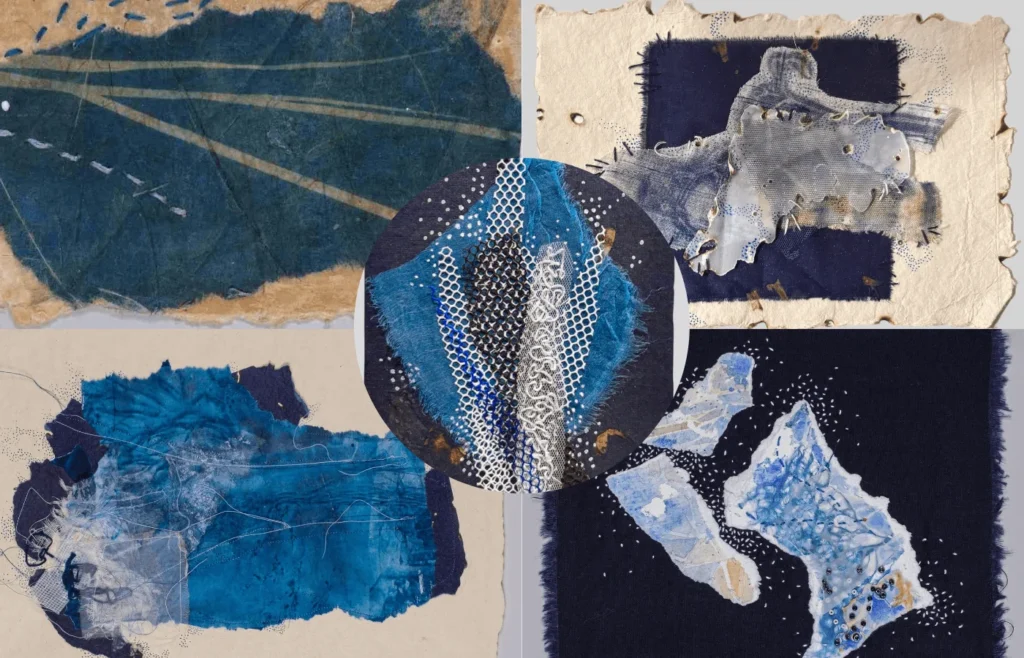Art of Radhika Surana
Growing up in Jaipur, artist Radhika Surana was surrounded by the soft, unhurried rhythms of a culturally rich city. At the time, she didn’t fully recognise how deeply its colours, crafts, and traditions were imprinting themselves on her creative soul.
“The indigo blue that was everywhere in the city, the embroidery traditions that lived in my own home, the relaxed pace of life — all of this formed the foundation of my artistic language,” she reflects.
With time, Radhika came to understand that this influence went beyond aesthetics. It was not merely about patterns or skills, but about embracing creation as an act of devotion. Repetition, for her, became less a sign of monotony and more a meditative rhythm — a practice in focus and presence.
From Fine Arts to Fabric
A Fine Arts alumna of Rajasthan University, Radhika refined her craft under the mentorship of celebrated artist Dwarka Prasad Sharma. Her quest for artistic depth took her abroad, where she studied portraiture and watercolour at Canadore College in Ontario and worked as an apprentice for Canadian artist Charlie Rapsky.
Yet, it was only when she began working with textiles that her creative journey found its truest home. “Embroidery felt like mending — like speaking my first language again. Holding the fabric close to my body gave me a sense of belonging, care, and continuity,” she says.
This profound connection to fabric forms the foundation of her latest solo exhibition, Somewhere I Have Never Travelled, currently on display at New Delhi’s Art Alive Gallery until August 20, 2025.
Indigo: A Colour with a Double Weight

The exhibition borrows its title from an E.E. Cummings poem and uses instinctive embroidery to explore emotional landscapes and human connection. Many of the works are dyed in rich indigo, intertwining personal memories with India’s textile heritage and its layered colonial history.
“Indigo is both deeply personal and historically complex,” Radhika notes. “It shaped trade routes and wealth but also carries the painful legacy of colonial exploitation and forced labour.”
Working with indigo, she explains, is a balancing act — both a tool for self-expression and a dialogue with heritage.
Works Born of Chance and Materiality
The exhibition features 63 artworks, each shaped by accident, texture, and the unique qualities of the materials.
- In one piece, tiny French knots interrupt beautiful waves created by hand-stitched gauze over cotton printed with cyanotype.
- Another work begins with bold indigo splashes, later softened using Japanese paper layering techniques.
- One textile mimics watercolour painting, layering cyanotype prints of plants with fabric scraps to build tonal depth.
- In a lichen-inspired work, brown and cream beads form a striking yet subtle contrast, evoking the textures of tree bark.
Thread as a Private Language
For Radhika, fabrics are not mere surfaces — they are collaborators. Once in her hands, they reveal their own nature, guiding her process.
“Over time, my stitches and gestures became like words in a private language,” she says. Restitched seams symbolize mending, knots symbolize intimacy, while burnt or slashed lines suggest breakage.
In her pieces, beauty and fracture coexist, much like in real human relationships. “It’s only by feeling an emotion deeply that you can express it authentically,” she says. Her slashes, burns, and repairs echo personal experiences of loss and healing, honouring both vulnerability and resilience.
Instinct Over Structure
Radhika approaches fabric the way she approaches Cummings’ poetry — with openness and instinct rather than rigid design. “Both have a quiet inevitability,” she explains, “unfolding organically, embracing asymmetry, and letting the soul guide the hand.”
Her hope is that viewers will leave her exhibition with an appreciation for the layered work relationships require — whether between people, cultures, or histories.
“Relationships are delicate,” she says softly. “You must understand each layer if you want them to grow.”
In Radhika Surana’s art, indigo and embroidery are more than craft — they are vessels of memory, care, and cultural reclamation, binding the threads of past and present into one continuous weave.


